As the seasons change, we may fall back into more sedentary habits. Health researcher Joan Vernikos has some tips for staying in motion and managing stress.
Dr. Joan Vernikos with Dr. Barb
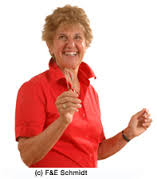 Dr. Joan Vernikos retired in 2000 as director of Life Sciences at NASA, where she was both a researcher and an administrator. Initially recruited by NASA because of her expertise in stress, she pioneered research on how living without gravity affected the health and post-flight recovery of astronauts. She’s published several books on gravity, aging, and stress, including The G Connection: Harness Gravity and Reverse Aging, Stress Fitness for Seniors, and Sitting Kills, Moving Heals. When she isn’t writing or keeping herself in motion, Dr. Joan consults with organizations on product development and whole workplace design, and serves as chair of the Taksha University School of Integrative Medicine’s Institute for Space, Health, and Aging.
Dr. Joan Vernikos retired in 2000 as director of Life Sciences at NASA, where she was both a researcher and an administrator. Initially recruited by NASA because of her expertise in stress, she pioneered research on how living without gravity affected the health and post-flight recovery of astronauts. She’s published several books on gravity, aging, and stress, including The G Connection: Harness Gravity and Reverse Aging, Stress Fitness for Seniors, and Sitting Kills, Moving Heals. When she isn’t writing or keeping herself in motion, Dr. Joan consults with organizations on product development and whole workplace design, and serves as chair of the Taksha University School of Integrative Medicine’s Institute for Space, Health, and Aging.
Listen now.
Dr. Barb: Welcome back for part two of our conversation with Dr. Joan Vernikos, a leading researcher in health, who retired from NASA as the director of Life Sciences. She’s continued work as an author, health coach, and speaker, sharing what she learned through the study of stress and gravity, and how they work on our bodies. She published Sitting Kills, Moving Heals, which continues to get well-deserved attention, and Stress Fitness for Seniors.
Now we’ll dive back into our conversation:
So, my understanding of what you are saying is, that culturally—the direction we’ve moved to make life more convenient, we’ve also made our lives more sedentary.
Joan: Yes, absolutely. And in the process, we are robbed of movement we used to do naturally—in the course of living.
Dr. Barb: So the findings of preserving wellness in the art of movement, in the persistence of movement, really is disconnected from weight. Because, I think in our healthcare arena we often focus so much of our discussion around weight and obesity.
Joan: That’s correct, and that’s fallacious, in the sense—well—It's an interesting discussion, I have my views on that, because obviously now you can reduce weight by switching to a fat-burning metabolic ketogenic state—without exercise—and there’s a whole side of the debate that, yes, exercise is good, but it is not the fundamental problem
Dr. Barb: And the reason exercise is good, is that it is movement, but in effect it’s the movement that is the critical part of this.
Joan: Yes, and you’re going to have a lot of trouble through exercise, for really the benefit being quite small. You know now in the exercise world, even the—how much exercise do you need to maintain aerobic fitness even, which I wouldn’t be my first sort of measure. It’s almost easier to maintain aerobic fitness than anything else. But this high intensity interrupted exercise regimes, they are HITT, that they are recommending now, will keep you fit as they say, I wouldn’t know [laughs], but they will keep you fit with two to three times a week, okay?
So what is it doing? High frequency, high intensity movement, and that’s in a way what we are talking about. But, it’s certainly easier and probably a better signal to the body, a more comprehensive signal, to alternate several times—and the other thing that’s very interesting is, throughout the day—let me tell you something. I gave a talk to an AARP group the other day and there was a lady doctor talking about social aspects of medicine. And she came to me afterwards and said, you know I loved what you said, because I have this Fitbit kind of device that measures fitness and this sort of thing, and how many calories I burned each day and the number of steps I take. And I decided that because I can’t go walking ten thousand steps every day, I have to do it during the day. So I walk about eight hundred steps an hour—I measured that I walk about 800 steps an hour. She said, what’s fascinating is that I noticed and this is okay and I told her that I burn 750 calories more an hour doing the same amount of steps, spread throughout the day than in one run of time. Now I thought that was absolutely fascinating.
Dr. Barb: But you weren’t surprised by that I take it.
Joan: No! It was really a reinforcement.
Dr. Barb: Fascinating, so for those of us who sit in front of a computer, my job is a combination of a lot of sitting with some movement throughout the day. But, for many people—it’s hard for them to incorporate movement throughout the day, so do you have any practical approaches to how someone might be more successful in doing their work? I will say our work days are somewhat structured, leisure time we could obviously all improve on and move more, but what about incorporating it into the work environments? Do you have any suggestions about how that might be accomplished?
 Joan: Yes, several. First of all I think you have to realize that it’s a question of habit. What are your habits? How did you get to these habits? Nobody made me do it, okay? I had someone in one of my talks say, Well I can’t do that, I’d be fired. I said, oh really? What do you do? He said, I’m a computer scientist. I said, yes, do you drink water? Do you go to the water fountain? He said, we don’t have a water fountain. Just tells you how old I am. And I said, okay, do you drink water? He said, oh yes I do, I have a water bottle I use. I said fine, put it on the desk next to you so that you have to stand up and go to the desk to get a drink
Joan: Yes, several. First of all I think you have to realize that it’s a question of habit. What are your habits? How did you get to these habits? Nobody made me do it, okay? I had someone in one of my talks say, Well I can’t do that, I’d be fired. I said, oh really? What do you do? He said, I’m a computer scientist. I said, yes, do you drink water? Do you go to the water fountain? He said, we don’t have a water fountain. Just tells you how old I am. And I said, okay, do you drink water? He said, oh yes I do, I have a water bottle I use. I said fine, put it on the desk next to you so that you have to stand up and go to the desk to get a drink
It is restructuring your habits. That’s probably the easiest and most fundamental. Because, once you get into the habit of structuring what you are doing, then, first of all, you raise your awareness. As you know, as a physician, one of the first steps towards a cure is awareness.
Dr. Barb: Of course.
Joan: Which unfortunately is not necessarily the way we practice. But, anyway… Awareness, so you become aware that sitting isn’t good for you, you go do something about it. But you can’t exercise every half hour which Joan recommends.
The other thing is, again, you change your habits. Go to see your colleague two offices down or two cubicles down when you want to say something to them. So you take the opportunity, you drink lots of water—you need to go to the restroom more often. These are all things—you put your printer far away from your desk so you need to get up to go and get it. It’s structuring your day.
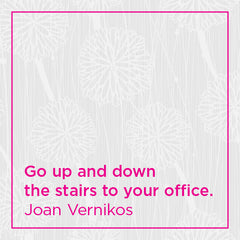 Now, let’s get back to other things that you can do is the stand-up meetings. I used to have stand-up meetings when I was the head of Life Sciences, you know, twenty years ago. Ten minutes of stand up meetings are much more efficient, you get much more done. Everybody was informed and you know—we got to move around. Stand up whenever you can. You go to a meeting, stand, lean against the wall, if you will, whatever. Make it part of your—if you have windows, have the windows open—they don’t have windows that open so much anymore, but if you have one, open the window.
Now, let’s get back to other things that you can do is the stand-up meetings. I used to have stand-up meetings when I was the head of Life Sciences, you know, twenty years ago. Ten minutes of stand up meetings are much more efficient, you get much more done. Everybody was informed and you know—we got to move around. Stand up whenever you can. You go to a meeting, stand, lean against the wall, if you will, whatever. Make it part of your—if you have windows, have the windows open—they don’t have windows that open so much anymore, but if you have one, open the window.
The restroom is a great place. At NASA the ladies room was a great discussion area. The [laughs] government investigator was on the same floor and she would come to the restroom; we used to have some great discussions, got all the gossip I ever wanted in the ladies room. My boss was very upset, he said, “How do you know this?” and, of course, the ladies restroom.
Dr. Barb: [laughs]
Joan: And of course, he couldn’t go, couldn’t argue with that, because he couldn’t join the conversation. So it was a great advantage to use the restroom.
There are all kinds of things you can do while you are sitting. Yes, there are contraptions of riding a bicycle, I have no idea if they work, but this distracting, I mean, I don’t know about you, but stand-up desks with treadmills is not my idea of getting work done. You don’t need it, if you have a stand-up desk that moves up and down with you, there are ways that you could use that. I prefer just to stand up, to stretch. I know a professor that has his students stand up and stretch at thirty minutes and then sit down again, and he claims their cognitive productivity is far better. So, now they have stand-up desks for children in school, some schools anyway.
Dr. Barb: Well, I think it's helpful to have some insight into this and recognize that it doesn’t have to be complicated. I think one of the things you stated is, all of the gyms that appear along the strip centers in America right now, but are we healthier? No, we’re clearly not healthier. And when you do think back on the generations before us and their lifestyle and just how they incorporated movement, even Europeans, which I’m sure you would agree, they tend to incorporate more of an active lifestyle
Joan: Correct. They do shopping, you see them walking on sidewalks, which is a sight you hardly see over here. You go up and down the stairs to your office, you go up and come down the elevator. I didn’t want to go up the elevator in the morning and see all these people I don’t really want to talk to, just because they happened to arrive at the same time as I did. It’s, you’re getting two for the price of one.
Dr. Barb: Of course, of course.
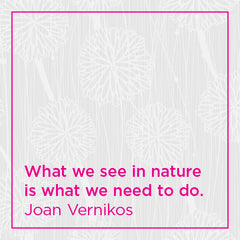 Joan: You’re getting a bit of time to think and you’re getting a bit of exercise. Going up is different from going down, different muscles, different activity altogether. So, that’s a simple one. Stretching, the way you sit at your desk, just sitting—pushing your elbows back. The good old business of putting a book on your head—you’re probably too young to remember that, but when I was young we had to put a book on our heads, it shows very quickly if your posture is bad, the book falls off. It is a simple thing that encourages you to sit up straight, it goes halfway to standing up.
Joan: You’re getting a bit of time to think and you’re getting a bit of exercise. Going up is different from going down, different muscles, different activity altogether. So, that’s a simple one. Stretching, the way you sit at your desk, just sitting—pushing your elbows back. The good old business of putting a book on your head—you’re probably too young to remember that, but when I was young we had to put a book on our heads, it shows very quickly if your posture is bad, the book falls off. It is a simple thing that encourages you to sit up straight, it goes halfway to standing up.
Dr. Barb: So, what I’m doing in yoga in the morning, you used to do in your classroom by just placing a book on your head.
Joan: Correct, exactly. And that I think, yoga is fantastic, it is much underestimated. But, when you stop and think about it, yoga mimics what we see in nature. What we see in nature is what we need to do.
Dr. Barb: Another area of interest for you has been stress, and managing stress. As a healthcare provider I feel that many of my patients identify stress as an obstacle to their wellness. They aren’t sleeping well, they can’t find time to exercise, I’ll say. You might say they aren’t motivated to move. I’m interested in better understanding: how do we define stress? Is there a way… we can advise people about that?
Joan: Stress is—yes. Stress is a stimulus, that’s all it is. If you apply stress to a piece of metal or wood, it will snap eventually, and it might bend in the process. It might bend in a way you would, where it’s more productive. It’s more flexible. So, I see stress entirely as a stimulus. Can you have excessive stimulus? Sure. But, it’s the filtration process, which is within you, well, the person—the individual, that is the mechanism.
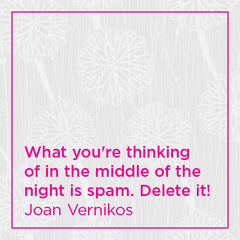 So I say to people, well you’re stressed. Eighty percent of your stress is self-made, easily eighty percent. You wake up in the middle of the night? Oh yes. Two o’clock in the morning, and what are you thinking about? All these things that could go wrong. Can you do anything about them right then and there? Well no. I say, when you turn on your computer, what’s the first thing you do? Well, I delete the spam. I said, bingo! You got it. What you’re thinking of in the middle of the night is spam. You can’t do anything about it. If you can—get up and do it! I find very therapeutic, I used to—that there are a few things, I used to anyway. Turning on the vacuum cleaner.
So I say to people, well you’re stressed. Eighty percent of your stress is self-made, easily eighty percent. You wake up in the middle of the night? Oh yes. Two o’clock in the morning, and what are you thinking about? All these things that could go wrong. Can you do anything about them right then and there? Well no. I say, when you turn on your computer, what’s the first thing you do? Well, I delete the spam. I said, bingo! You got it. What you’re thinking of in the middle of the night is spam. You can’t do anything about it. If you can—get up and do it! I find very therapeutic, I used to—that there are a few things, I used to anyway. Turning on the vacuum cleaner.
Dr. Barb: That has not occurred to me.
Joan: My neighbors must have loved me. But, you want to do something that is productive, not necessarily related to the stress you’re conjuring up in your brain, but it is productive. You see an end result. Cook. I used to cook for my kids a week’s worth of cooking and put them in pots and freeze them. What I did was bulk cooking. Do something. Do something that gives you immediate result. And believe me, you’ll go back to sleep, to bed and sleep like a baby.
Don’t turn on the TV. [laughs] Unless it’s something you’ve already seen and you know the outcome, so you’re not going to get upset by what you are going to see, because you already know what is going to happen. And I do that. My husband laughs, because I love mysteries and I’ll stay up late at night to see them. He says, “You’ve seen them before!” I say, “Yes, but the other night I saw one I hadn’t seen before, I didn’t sleep!” Because it upset me. You must not get upset before you go to bed.
You start turning the lights down at least an hour before you go to bed. And when you go to bed it’s absolute darkness. Yes, I say that to my clients. You turn off all the lights. Oh, but where is your cell phone? “It’s under my pillow.” Take it out, especially the young people; it’s amazing. Turn it off! Nothing is going to happen while you are trying to sleep.
Dr. Barb: Has your research reinforced the importance of adequate sleep in bodily function and wellness?
Joan: Oh yes, absolutely! I’m talking about moving during the day, okay? I can give you my night version, as you know, it’s a very active period. But, it’s very interesting, because if you change your—you change the direction of gravity, so you start to expect the changes you see when you’re lying in bed for 24 hours. Well, it doesn’t happen during the night. And this came from a doctor named Reed many years ago. He was at MIT, he’s probably retired, but he was studying calcium excretion as an indicator of loss from bone. And he was a circadian rhythm person, so he collected the samples from times both days and night. And his question was, Okay when I put this person lying in bed and reduced gravity, I increase calcium excretion. What happens during the night? Does calcium excretion increase as well? Well, it doesn’t. The body, the kidneys shut down and you do not get increased calcium excretion in the night—in response to lying down.
Dr. Barb: So, in effect the body knows that sleep is a time of restoration and preservation
Joan: Exactly, and activity, but not in that metabolic active outcome, the hormones increase, the target organ does not respond during the night. Okay? Now, I have been after my colleagues—my sleep colleagues—for heaven’s sake, study the night! Because that’s when it’s really interesting. But, you know, people, we’re lazy, we only work during the morning, during the daytime.
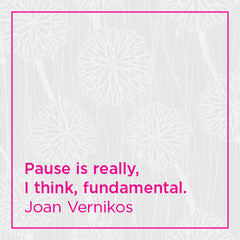 But what happens that is very exciting, as you probably know, it’s like a cleaning service in an office. When the office shuts down, the cleaning service comes in to clean the place during the night. And the cleaning service starts out by emptying the garbage cans, by tidying up, picking up and eventually it goes through a process-and that’s what happens with the brain during sleep in the various cycles. And then what happens, is you detox. You don’t just detox during the day, you detox your brain, and there’s a brain detoxing mechanism involving the glial cells that has now been identified. That goes on only during periods of deep sleep. So, if you wake up and you don’t sleep well, not only are you going to make mistakes the next day, but you’re just not going to detox your brain. Well, imagine having a non-detoxed brain, because you’re not giving it a chance to detox. Of course you’re going to get dementia, of course you’re going to get all kinds of neurological conditions, because the poor brain hasn’t had a chance to pause. And pause is really, I think, fundamental. It’s not just moving, but pauses, it’s the interruptions that are—intermittent interruptions are so necessary to maintaining good health.
But what happens that is very exciting, as you probably know, it’s like a cleaning service in an office. When the office shuts down, the cleaning service comes in to clean the place during the night. And the cleaning service starts out by emptying the garbage cans, by tidying up, picking up and eventually it goes through a process-and that’s what happens with the brain during sleep in the various cycles. And then what happens, is you detox. You don’t just detox during the day, you detox your brain, and there’s a brain detoxing mechanism involving the glial cells that has now been identified. That goes on only during periods of deep sleep. So, if you wake up and you don’t sleep well, not only are you going to make mistakes the next day, but you’re just not going to detox your brain. Well, imagine having a non-detoxed brain, because you’re not giving it a chance to detox. Of course you’re going to get dementia, of course you’re going to get all kinds of neurological conditions, because the poor brain hasn’t had a chance to pause. And pause is really, I think, fundamental. It’s not just moving, but pauses, it’s the interruptions that are—intermittent interruptions are so necessary to maintaining good health.
Dr. Barb: Well, these discussions are fascinating and I think important for so many people to hear, because by nature, we—most of us—have not created a life that is conducive to living well as you’ve just described to us. So, I appreciate your clear descriptions and explanations of why some of these things are vitally important to our aging and wellness.
I’d like to turn away from science, although science is fascinating to me, and ask you a more personal question. Having had a career in NASA and having seen the movie not too long ago, of Hidden Figures, and understanding women in that industry—can you share what it might have been like to be a woman working in such a male dominated area?
Joan: Yes, and I—Hidden Figures I think was fantastic. But that was a lot more than just being a woman. As we are aware. They had the double whammy really.
Dr. Barb: Of course.
Joan: I always considered myself extremely fortunate, extremely lucky in my career.
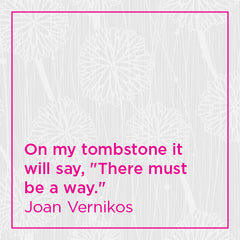 First of all, my father was sixty years old when I was born, so I had what other people considered an old father. I never thought of him that way. He was a physician at the time when they didn’t have MRIs and scans. So he was known for being a good diagnostician, using his hands, listening to you. And having a conversation with these patients. So, I was used to that. And then he would discuss if there was anything interesting, my sister and I—he didn’t have any sons, so my sister and I and my mother, who didn’t have a university education, would ask him and listen to what had happened that he could describe that day. And so we learned how he went about solving the problem.
First of all, my father was sixty years old when I was born, so I had what other people considered an old father. I never thought of him that way. He was a physician at the time when they didn’t have MRIs and scans. So he was known for being a good diagnostician, using his hands, listening to you. And having a conversation with these patients. So, I was used to that. And then he would discuss if there was anything interesting, my sister and I—he didn’t have any sons, so my sister and I and my mother, who didn’t have a university education, would ask him and listen to what had happened that he could describe that day. And so we learned how he went about solving the problem.
My husband says, on my tombstone it will say, “There must be a way.”
Dr. Barb: I love that! That is wonderful
Joan: I think that it is a great compliment
Dr. Barb: It is a beautiful compliment!
Joan: And so, I—people say, well what’s your asset? What do you bring to this thing? I say, solving problems, and I don’t mean crossword puzzles and the like, because I’m not very good at that sort of thing. But, I love the mystery of the human body, and that’s what it is, it’s an absolute mystery. We think we know a whole bunch and every so often there’s a whole fad of measuring weight or measuring DNA or ATP or whatever is discovered and everything is interpreted in those terms. And it’s good, but certainly not the last word.
So, I was, I started telling about my father. I got an apprenticeship education, let’s put it that way. That was a great fundamental sort of foundation to my approach to things. And also, stepping back and looking at things from a different perspective—not from the way the book said. That’s where I got my flair if you will, and I must also tell you that I retired from NASA in 2000, almost twenty years ago. I started really thinking after I retired, I did not have time to think before. Now, NASA—so anyway, my father expected both my sister and I to become doctors. My sister became a doctor and I chickened out. The first time I went through the morgue it, you know, turned me off. Which was unfortunate, but that’s okay. I made good in the long run
Dr. Barb: It worked out for you.
Joan: Yes! I would have taken a different career, I’m sure. So, it’s how can I put it? I was not used to being treated differently; he expected us to become professionals. When you stop and think that he was born in 1875, it was miraculous that a man would expect his daughters to become professionals. And we’re talking eons ago.
It never occurred to us to be anything else. It just didn’t happen. When I went to England to do my PhD, I was very lucky, because the way they treated women professionals was no different than they treated men. They were as tough on you with questions after a presentation, they would not open the door for you to enter a car [laughs] or treat you differently. And they were as harsh as could have been. There were exceptions obviously, there was misogyny along the way, but I wasn’t treated differently. So when I went to Ohio State to teach for oncology and medical school I couldn’t believe how everybody was doubling up to come and open the door for me and at presentations or conferences the questions after my paper were very mild. And then, word got around to me that so and so were having this discussion about you and your paper and oh it was very critical. I thought, you know, why didn’t they tell me?
That gradually made me turn around and say, hey, I’m treated differently here! I would come along and say, I don’t know. After a while they believed I didn’t know. But that was not the way I was using, “I don’t know”; I was using it because I wasn’t sure about it, or I wouldn’t speculate necessarily. But, it was taken as “Aha”! You see, you really are reinforcing that you do not know. I changed. My first husband called it the rejuvenation of Joan, the reorientation of Joan, because I suddenly acted American. There is a lot more discrimination here than in the rest of the world.
Dr. Barb: Hmm, so some of this was cultural.
Joan: Cultural, yes. Now, when I went to NASA, there were people—I discovered that leading from behind was more important than forefront, if you understand what I mean. And if there was a discussion, and if people were rude, I would not hear it as discrimination for me, I would hear it that they’re rude. They are rude people. So, I did not—it didn’t impact me as an individual. And I found that I could be very effective leading from behind, given the right kind of people to work with. I never applied for a job except the job of Director of Life Sciences. Somehow or another, someone always promoted me, put me up for this or that or the other.
Dr. Barb: So, as we wrap up our time together, Joan, I’d like to ask the question about: Where do you at this stage in your life find richness?
Joan: Oh, I have passion for my work and for communicating to the public.
You realize as a scientist, you know, we talk to each other, I wrote scientific papers galore. And when John Glenn, bless his heart, flew the second time around, I was very instrumental, because I was director of Life Sciences. I had a lot of interaction with him to persuade the political forces to let him go the second time around. And there was resistance from the other younger astronauts, because he was taking up one of their spots—cherished spots. Anyway, he flew as you all know, but in the process, I had to guard and do a lot of interacting with the press and beginning to interact with the public, to some extent. I had to present why he flew, how he did, and what we’re going to learn from it. A lot of criticism.
And to field that, and I found out at the end of my talks, that people would come up to me and say, how come we’ve never heard of this before? Where can I read more about it? And I scratched my head and thought, well, there isn’t anything. There's a textbook in aerospace medicine, but nothing for the general public. When I finally two, three years later, decided to leave NASA, I left NASA so that I could write something. I expected to write a few notes, and it ended up being The Gravity Connection, the G connection book. To be able to say to people, here is a book that might help you.
Mind you, I had to struggle, because as a scientist I have a hard time writing. I can communicate, but I have a difficult time writing, so I had to struggle to put that book together. But it was my first entry to the general audience. And how to present and how to make it simpler and simpler and simpler… And how to develop analogies and examples so that people could take it away with them. So that’s what I did and that’s how slowly the one book led to the other, led to the other.
And my husband kept saying, “You have to write a book about stress,” and that’s where Stress came from. I’ve got another book that is finished, but needs to be published called Stress Beyond 50 but I haven’t had time to go get it published. But, talking to people, I’ve gotten questions that I had to answer. So I learned, they thought, they gained, and so it goes. I’m passionate about what I do.
Dr. Barb: It’s obvious that you are and I’m thrilled that I could have this time with you today. And that we can share this conversation with so many other women, to be inspired by your work, your vision, your aspiration, and that you continue to be inspired about a very important area and that you are able to continue to communicate it so broadly. Thanks so much for your time today, Joan.
Joan: Oh thank you so much! As you can see, I love talking. [laughs]
 Dr. Barb DePree, M.D., has been a gynecologist and women’s health provider for almost 30 years and a menopause care specialist for the past ten.
Dr. Barb DePree, M.D., has been a gynecologist and women’s health provider for almost 30 years and a menopause care specialist for the past ten.


0 comments